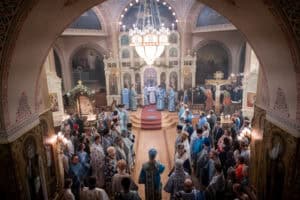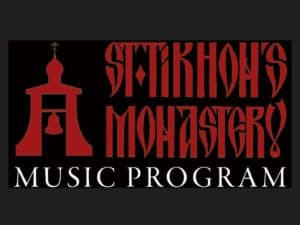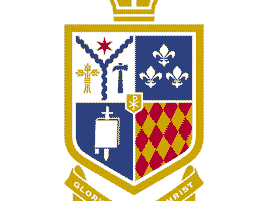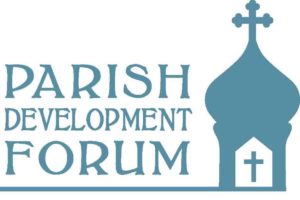PART II
In his introduction to Orthodox America, published in 1975, Fr Schmemann offers three signs by which we might begin to discern and decipher the revealing of God’s will to us: mission, the local church, and the suffering of the cross. But, it is the phrase under which Fr. Schmemann lists and organizes his ‘three signs’ that I would like to use as my point of departure:
“To love is to remember. And to remember with love is truly to understand that which one loves and remembers, to appropriate it as God’s gift. Thus with Orthodoxy in America.”
I think it is important that Fr. Schmemann in his preface classifies the work that follows – Orthodox America, 1794-1976 – not as ‘history,’ but as an act of ‘memory.’ Why so?
If the insights of modern psychology and sociology as well as hermeneutic philosophy are to be taken into account, it is precisely memory that determines a thing’s meaning. That is, how something is remembered – how it is processed, stored and retrieved in the human brain – forms a crucial component of the ongoing significance of anything that we, either personally or collectively, deem worthy of remembering.
In short, memory is an interpretative tool. The act of remembering is an interpretive act.
To lose sight of this is to allow what is a deeply human function – one that encompasses meaning and significance, even love – to calcify into something like ‘history,’ an external, supposedly unbiased (but usually deeply biased) account of ‘what really happened.’ It is to deal in static ‘facts’ rather than dynamic, living truths. Or, perhaps put another way, it is to forget that the writing of history is itself an interpretive act, an act of collective memory!
I would propose that the rhetoric surrounding the granting of autocephaly to the Orthodox Church in America – both then, represented in the Tomos of Autocephaly and related commentary, and now, in reflection upon that rhetoric and its appropriateness/inappropriateness to our current context – functions in a similar manner, as interpretation. It more properly occupies the realm of memory than history.
To speak specifically: it is important to keep in mind that the recognition or non-recognition of the autocephalous Orthodox Church in America was and is itself an act of interpretation; as was the choice to name the Metropolia, the ‘Orthodox Church in America’; as was the selection of St. Herman of Alaska as its first, local saint. An act of interpretation, too, was the choice to include the previous 200 years of Orthodox mission in North America in the ‘story’ of the OCA represented in Orthodox America, 1794-1976 (both to represent continuity and to appropriate all of this as one’s own). And so is the choice to memorialize all of this now upon the occasion of fifty years of autocephalous existence an act of interpretation.
How do we understand what has happened? What does it all mean? Is it significant, and why so? These are the questions to which we seek answers, which is the work of interpretation.
This is not to say that all this is merely interpretation. It is rather to say that the interpretive act is where the leading of the Holy Spirit meets the very human work of sorting through possible meanings.
Yes, the insights of modern psychology and sociology (and modern/postmodern hermeneutics) help cast light on how this works. But, the work of interpretation by way of memory is also entirely scriptural, too.
Consider the words of the LORD: ‘I am the God who brought you out of Egypt.’ Is this not a memory that constituted who Israel was and how she lived her life? Or, consider the memorial-stone, the eben-ezer, erected by Joshua after deliverance from the Philistines. Recall the importance of the memory of Jerusalem when in exile, epitomized by Ps. 136 (137). Recall the words spoken at the institution of the Lord’s Supper: ‘do this in remembrance of me;’ or, the memory of Jesus’ words that evoked the ‘a-ha’ moment for the disciples. What is the apostolic kerygma but the interpretive seed that grew into the Tradition to which we hold fast?
Let’s not forget that memory and the work of remembering are at the heart of our liturgy, both because it is an essential part of the Jewish pattern of prayer to which we are heir, and because, as Fr. Schmemann pointed out, memory and love are inextricably connected. How do we as creatures endowed with memory assign significance to God’s acts on our behalf? How do we comprehend his love for us or express our love for him? By a highly-interpretive act of memory.
Memory is integral to the Spirit-led work of what Fr. Schmemann calls, ‘discerning and deciphering the signs by which God has been revealing his will and his design to us,’ the work of interpretation that, in each new generation, God’s people are called upon to do in cooperation with the Holy Spirit. Memory is integral anywhere that work is taken up: from the Divine Liturgy to how we choose to remember and memorialize ‘our story’ as Church.
This is not to say that interpretation is fabrication. It is not a front-loaded process whereby the Church in America defines itself or dictates where a legitimate and sanctioned location is where the Holy Spirit may or may not be at work (as though we can control such a thing!).
Instead it is, by its very nature, a ‘following after’; and, in the Church, that means a following after the Spirit. It is to look back (always back!) and realize the ‘given-ness’ of something, ‘to appropriate it as God’s gift,’ and to sort out the implications and ramifications of that gift.
It is an after-the-fact act of re-cognition whereby God is the principal actor, and we the ones who, in the wake of God’s acts, are left to the task of translation and witness. In light of what God has done, what are we to do; how are we to live? It was the same way for the Israelites on the far shore of the Red Sea. It was the same for the Myrrhbearing Women confronted with the empty tomb. It is the same for us today.
To choose to engage in this work means attention to the Spirit. It ought to lead, as our pattern of prayer is wont, through anamnesis to doxology and praise to God for ‘all that has come to pass for us.’ It can be an act of love. Conversely, to choose not to engage in this work means inattention to the same Spirit. It can be a missed opportunity to bring praise to God. By Fr. Schmemann’s definition, it is not to love.
But why bother pointing this out? Why recall the essentially interpretive nature of collective memory, even as it relates to the Church?
Because it implies responsibility for our interpretation. It implies responsibility to be faithful witnesses to what God has done and is doing; responsibility to join in that work of ‘extending the mission’ in America; responsibility to our faults and missteps along the way; responsibility to confess the ways we have failed to live up to our high calling in Christ. It implies responsibility to repent.
If our acts of memory and memorializing work to establish the meaning of a thing, then, as much as we are able, it behooves us to ensure that the interpretive choices we make are in conformity with what we believe and confess, and that the memorials we erect point beyond themselves to something of true significance.We bear a responsibility to ensure that the meaning of American autocephaly is Christ and the Gospel, and not the need to express national identity, or the ideal of self-determination, or merely an example of the rebellious spirit of the 1960s and 70s. If the meaning of American autocephaly is to be something besides these, then what we choose to remember, what we choose to emphasize – how we choose to tell our story and how we choose to act in light of that story – matters.
No doubt, there is no small dose of ‘it seemed good to the Holy Spirit and to us’ involved in this fraught and humbling work; but, it also reminds us that this is a cooperative process, and we have not been left without indications, signs, of what constitutes an appropriate interpretation. In this, Fr. Schmemann was perceptive in his selection of signs: mission, local identity, and the suffering of the Cross. If present, these signs serve as translatable marks that the Holy Spirit is at work.
But, notice, again, that all of these point to conformity with the Gospel of Christ. Only if we can look and, in some sense, ‘discern Christ’ do we dare say of autocephaly that ‘it was a good thing then,’ and/or ‘it is a good thing now.’ If these are evident, then it would seem appropriate at this juncture to memorialize and establish with humility something of the significance of fifty years of autocephaly. It would be appropriate, even, to celebrate with thanksgiving.
Then would autocephaly function something like Fr. Schmemann envisioned: as a memorial ‘marker’ set up in recognition of what God has done, where he has led, and where he is leading. Then, and only then, would it function as a memorial ought, not as a dry statement of past happenings but as a living reminder of who God is and who we are as a result. It would function as a renewal of covenant and promises, and an encouragement to ongoing faithfulness.
My own institutional memory as a convert to Orthodoxy a mere twelve years ago is rather brief. All that I can relate is my own experience of being received into the Church within the OCA, in the context of one particular parish, one particular deanery, diocese, etc. And though it has been, as with all human experiences, a ‘mixed bag,’ I have experienced evidence of these signs.
I have experienced mission as Fr. Schmemann characterized it: as the ‘total identification of the Church with the people and with their real needs, spiritual as well as material;’ in the choice of my home parish to remain a parish in its impoverished neighborhood; in the oft-OCA-led efforts of FOCUS; in the vigilance of priests lovingly to correct false dichotomies of us/them, often within their own parishes. What is the Gospel but this ministry of identity and presence, incarnate first on the part of God, and then incarnate in his Church?
I have experienced a church with a local identity, even if arrived at unwittingly; a church that is a melting-pot; a church oh-so American: neighborly, civic-minded, and intelligent, yet at times prone to exceptionalism and a fondness for tabloid and internet vitriol. But, I have also experienced a church that has turned the best of these traits to its advantage – in its participation in efforts at jurisdictional unity (SCOBA/ACOBUSA, etc.), in its willingness to dialogue with other non-Orthodox Christian denominations (WCC, etc.), and in its regular, if cautious, contributions to societal conversations.
Finally, I have experienced something of the suffering of the Cross my short time in the OCA. I do not romanticize the ‘troubles’ of the past two decades (see ‘responsibility to repent’ above). Rather, I mean to say that, as the Church, we are offered opportunities either to ‘remain with’ and ‘suffer with’ the errors of the people (and repent of our own sins), or to disassociate ourselves from the errors of the people (and our own sins), whether by culture wars or some other mechanism. In Metropolitan Tikhon’s most recent general address to the 19th All-American Council, the OCA and its leadership showed a willingness to ‘remain and suffer with’ the errors of the people.
These things and more, taken together, present, at least to this convert, a discernible icon of Christ, one which might not have been seen otherwise were it not for the autocephaly that has enabled it. However suspect or unfulfilled one might feel that autocephaly is, by these signs it may still function as a memorial of what God has done and of what he is doing. The Orthodox Church in America has borne in its own halting, human way signs of the Holy Spirit’s activity. Will we choose to remember it?





